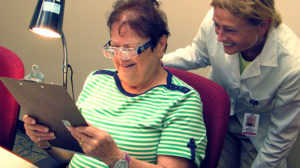Blog
Transformative Technological Advancements for the Patient with Low Vision


The advancement of technology has transformed the world, including how we live, work and interact with one another. Technological advances also have revolutionized medicine, to improve the lives of patients who once were seen as untreatable.
“Technology offers the best options for patients with low vision. There is so much available to make living with low vision easier,” says Laura C. Sperazza, OD, Director of Low Vision Services at Lighthouse Guild. An optometrist who specializes in low vision, she says, “Patients need to be made aware of the options that technology offers.”
Many technological advances in optometry are specifically designed for patients with low vision, including the Argus II Retinal Prosthesis System (Second Sight), the first implanted device to treat adults with severe forms of retinitis pigmentosa; the BrainPort V100 (Wicab Inc.), an oral electronic vision aid that translates digital information from a video camera into gentle electrical stimulation patterns on the surface of the tongue; and residual vision glasses, a head-mounted depth camera that displays information about the distance of obstacles to the wearer in terms of brightness.
“There are many apps available to help low-vision patients, and smartphones offer large print, text-to-speech and contrast enhancement that are essential to these patients,” Dr. Sperazza says. “Additionally, there are apps that can identify objects and speak the name to the patient, GPS to help a patient navigate both indoors and outdoors, and facial recognition software that identifies friends and family members who are approaching the patient. All of these are relatively inexpensive and easily accessible, and can allow patients to be independent and live normal lives.”
An important issue, Dr. Sperazza explains, is for patients to understand their vision loss and develop a willingness to use low vision devices and technology instead of waiting for a miracle cure.
“In my opinion, 80% of low vision care is counseling,” she says. “Patients need a doctor who is able to talk to them about their conditions, understand how it is impacting their lives and direct them to the best path to help their rehabilitation. Taking the time to listen to your patients is invaluable—it builds trust and understanding, and lets the patient know they have not been abandoned.”
While technological advances have benefited patients tremendously, Dr. Sperazza notes a need for more studies and clinical research to confirm the validity and effectiveness of these aids. “Technology has made tremendous strides in helping patients with low vision, but this is just the tip of the iceberg because there are no limits to where technology can go,” Dr. Sperazza says. “I would envision bypassing the eye and going straight to the brain to help patients regain vision or using artificial eyes in the future, although I am not aware of advances in this area now. I wouldn’t be surprised to see this in the future.”
Join our Mission
Lighthouse Guild is dedicated to providing exceptional services that inspire people who are visually impaired to attain their goals.
